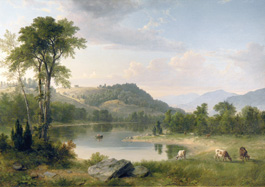From November 12, 2008 - February 15, 2009 the Cantor Arts Center at Stanford University presented “Dürer to Picasso,” the first in a yearlong series of exhibitions spotlighting the museum's collection. With 100 works from the Renaissance to WWII, “Dürer to Picasso” represented the top tier of art acquired through gift, purchase, and bequest since the museum's reopening in 1999, after a closure forced by the 1989 Lomia Prieta earthquake.
Major paintings and sculptures formed the central axis of the installation.
François-André Vincent's late-18th-century painting of

Zeuxis choosing his models,
greeted visitors at the exhibition entrance.
This showed an artist at work in a scene drawn from classical text, and the composition centers on the artist, his canvas, and his models.
“Summer Landscape,” (below)a bucolic view of the nation's still sparsely populated agrarian land, is by Asher B. Durand, an eminent 19th-century landscape painter of the United States.
Pablo Picasso's painting of a young woman,

“Courtesan with Hat,” 1901,
presents its subject with bold patterns and colors.
Hans Arp's smooth, elegant white marble sculpture “Silent,” 1942, with its biomorphic forms, carries abstraction further still.
Works on paper completed the exhibition. Sixteen engravings by Albrecht Dürer, the greatest painter and printmaker of the Northern Renaissance, revealed his humanist insights expressed through rare technical virtuosity. Other groupings of prints included etchings after Pieter Breughel the Elder of mountainous landscapes, lithographs of John James Audubon's animated quadrupeds, and symbolist visions by Odilon Redon.
Edvard Munch's color woodcut,

“Evening (Melancholy)” of 1902
is haunting in its depiction of solitude, which for the artist often verged on despair. Munch's use of simplified forms and wood grains make his work fresh and expressive. The new directions of 20th-century art can be seen in a cubist still life by Georges Braque, the fragmenting world of Wassily Kandinsky, and the surrealism of Kurt Seligman.
From Metroactive: (Images added)
Even as styles vary from the 15th-century realism of Dürer to the 20th-century abstractions of Arp and Miró, a thread of technical mastery links many of the pieces. It took the hands of a master like Rembrandt to create the exquisitely dense, smoky drypoint etching
The Star of the Kings: A Night Piece;
just as impressive is the woodcut Melancholy (Evening) , an equally black-ink-suffused landscape with a single musing figure in the foreground by Munch. Of course, talent alone isn't enough, Félix Bracquemond's 1884 etching King David With an Angel of Inspiration is technically adept but borders on kitsch.
Dürer is represented by a large and scary engraving of

The Four Horsemen of the Apocalypse
(whose hoofbeats seem to be thundering loudly these days)
and a suite of miniature prints depicting the passion of the Christ. The magnifying glasses provided reveal an astonishing level of detail.
The Harrowing of Hell
is crowded with demon heads, while a swollen-bellied dragon drapes himself across a ruined arch, all in a space no bigger than 3-by-5 inches. It's no wonder that the artist liked to mark his bravura pieces with a confident monogram—a D tucked under a stately, architectural A.
Just as anxiety inducing is an etching from Goya's Los Proverbios series. In
One Way to Fly; Where There's a Will, There's a Way,
men with flexible wings attached to their arms glide through a night sky—are they products of a fevered imagination or portents of things to come?
Odilon Redon's 19th-century lithograph illustrations for Flaubert's The Temptation of Saint Anthony are full of curious phantoms: an eye on a fleshy stalk, a chimera with a hood like a cobra about to strike, a one-legged monstrosity known as a skiapod. Both artists display an uneasy familiarity with the realm of nightmares.
Even an 1801 portrait from nature by English engraver William Ward traffics in menace. A huge Dragon Arum blossom with a single black spadex, or spike, jutting from a deep-crimson leafy sheath against a lightning-filled sky looks more like a scene from the Book of Revelations than a botanical illustration. By comparison, the teeth-bearing squirrels in John T. Bowen's large lithographs taken from Audubon paintings seem almost domesticated.
Forgoing hair-by-hair detail for vividness of impression, Canadian artist Sybil Andrews' color linocut
Skaters
features two dashing athletes pushing so hard that they look ready to burst out of the frame; their cocked arms and bent knees are all pointy angles. Two four-block linocuts by English artist Claude Flight use the technique's sharp edges and bright color to almost Cubist effect.
The calmest piece was
Summer Landscape (1854) by Asher B. Durand,
one of the leading proponents of the Hudson River School. The large landscape depicts a broad swath of still water in front of a distant mountain. Ruminating cows, always a sign of rustic contentment in paintings, amble along the banks; some canoers glide by in the middle ground. Mankind is perfectly integrated into this tranquil vision of nature.

_-_WGA7309.jpg)
_-_Google_Art_Project.jpg/800px-Francisco_Jos%C3%A9_de_Goya_y_Lucientes_-_Where_There's_a_Will_There's_a_Way_(A_way_of_Flying)_-_Google_Art_Project.jpg)


